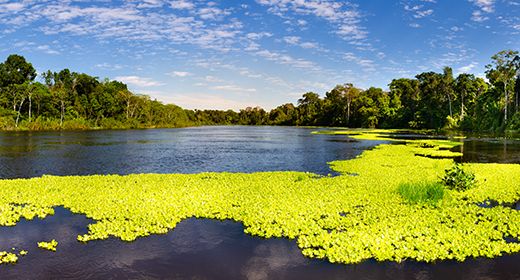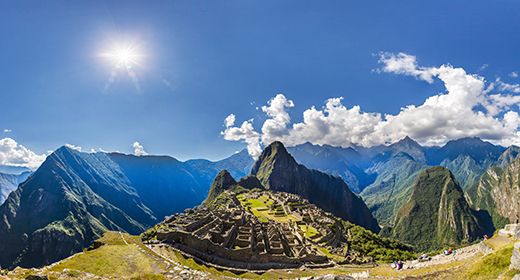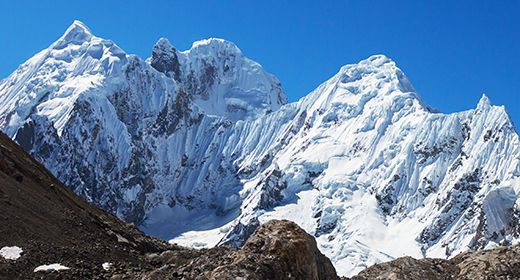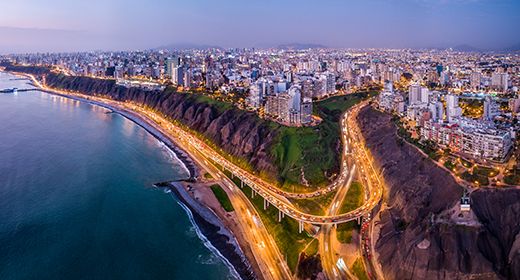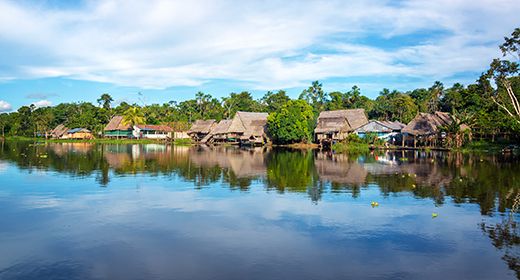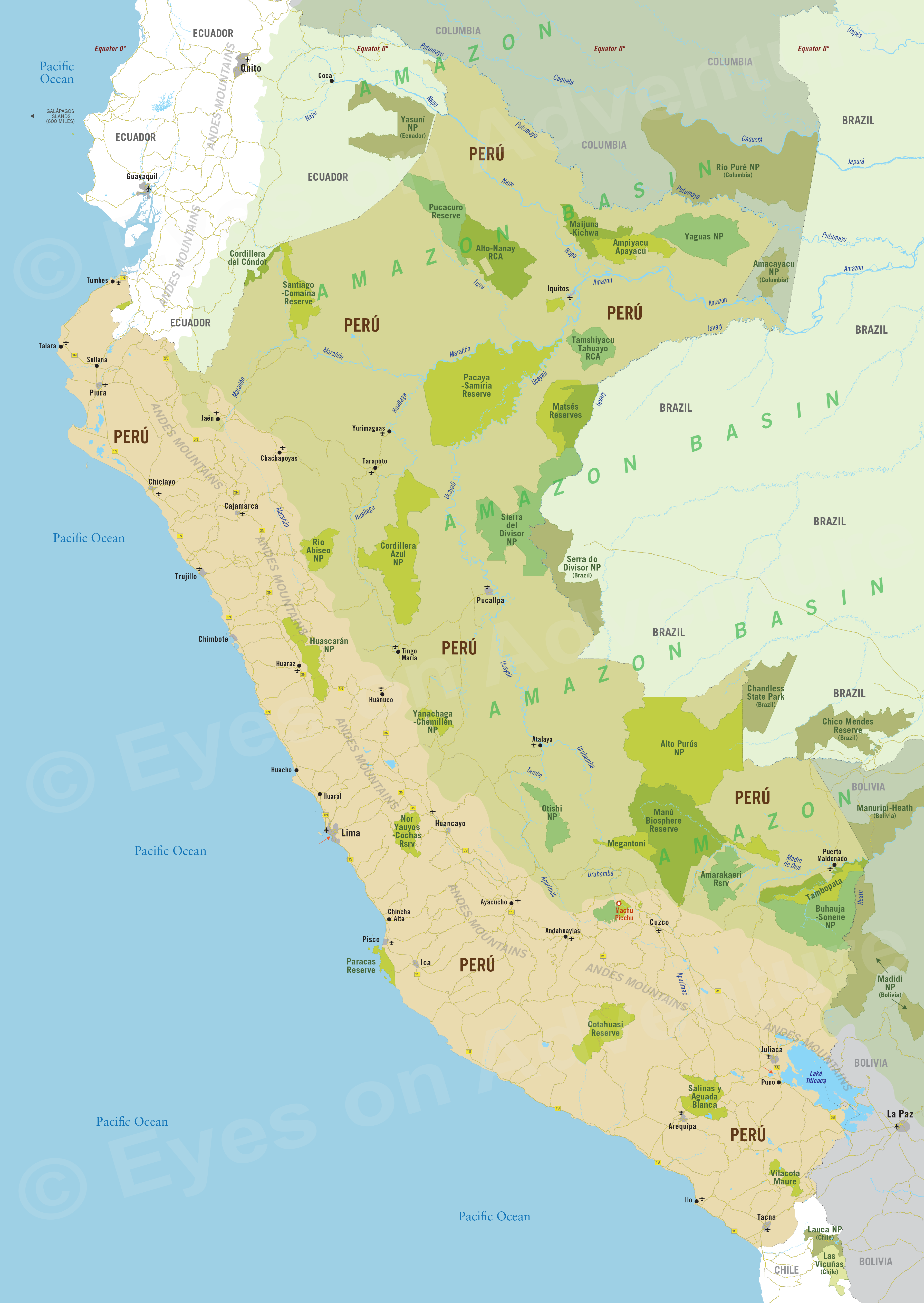Perú
Region Links: Perú Amazon North, Perú Amazon South, Sacred Valley
Highlights
- The Sacred Valley of the Incas with myriad ancient ruins.
- The ancient citadel of Machu Picchu and hiking the Inca Trail.
- Peru's two section of Amazon rainforest.
- Tambopata Reserve and Manu National Park for wildlife and birds.
- Multi-day Amazon River boat cruises from Iquitos city.
Peru is best known for its rich history, which includes the once-dominant Inca Empire, the ruins of which can be seen today throughout much of the country.
One of South America's most diverse countries, Peru is home to the Sacred Valley of the Inca people, which includes the ruins at Machu Picchu (the country's most visited destination), two sections (one in the north and the other in the south) of wildlife-rich Amazon rainforest, the Andes Mountains and highland villages, miles of ocean coast, and a variety of ancient cities.
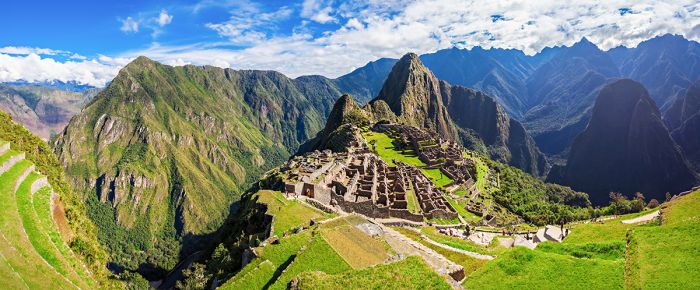
A visit to see the Inca ruins at Machu Picchu is a must do while in Peru.
The Sacred Valley
The Inca civilization, which rose to prominence in the Peruvian highlands in the early 13th century and became the largest empire in pre-Columbian America, occupied a large portion of western South America. Its administrative and political center was the city of Cusco, in what is now known as the Sacred Valley.
At its most powerful, the Inca empire included modern-day Peru, western Ecuador, western and south-central Bolivia, northwest Argentina, the southwestern edge of Colombia, and a large portion of modern-day Chile, and was a state comparable to the historical empires of Eurasia. The Inca empire ended when the Incas were conquered by the Spanish during the 16th century.
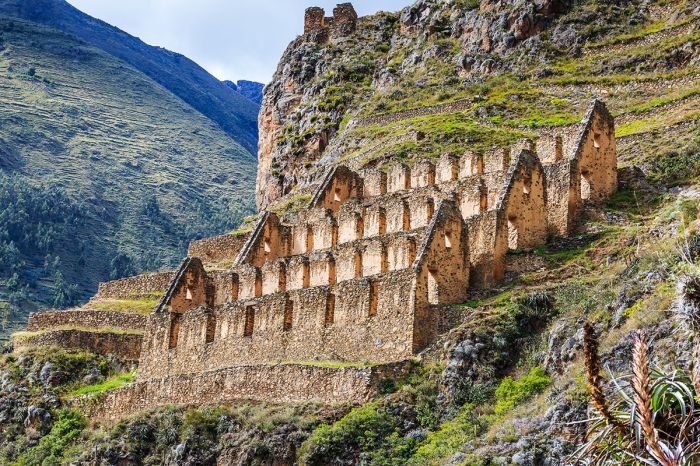
Ruins of Inca storehouses at Pinkuylluna site, near Ollantaytambo Sacred Valley, Peru.
The city of Cusco was built by Spanish conquerors atop the remains of Inca palaces and temples. Modern-day Cusco is a bustling city full of Andean culture, Inca ruins, and is the launching spot for most tourist explorations of The Sacred Valley and surrounding highlands. There are a large number of ancient ruins that can be visited on driving day-trips from Cusco, including Ollantaytambo, Písac, Chinchero, and many others.
The very popular, but challenging, Inca Trail takes over two days to hike, offers incredible vistas, stop-offs at various Inca ruins, and ends at Machu Picchu. The hike requires good fitness due to the steep mountains and altitude, but is well worth it for travelers who love to hike. Those who wish to skip the hiking adventure can also ride a luxury train to see the ancient citadel.
There are a number of other hikes in the mountains above The Sacred Valley, some of them short and some involving many nights of camping.
For more information about The Sacred Valley, visit the Sacred Valley region page.
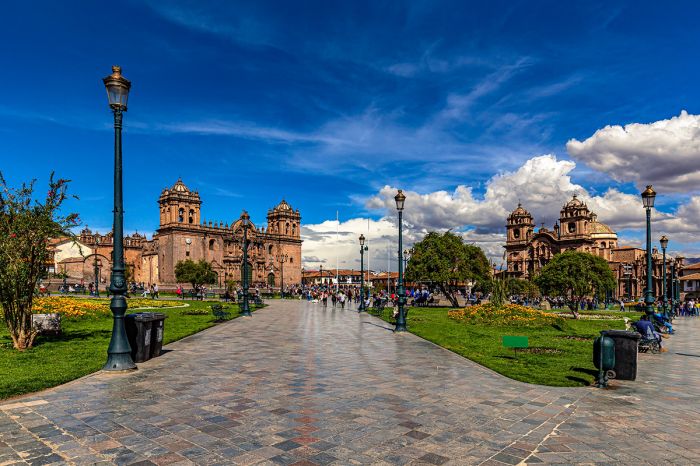
The 'Plaza de Armas', Cusco's main square, Sacred Valley, Peru.
The Amazon
Well over half of Peru is covered by the western portion of the Amazon rainforest, one of the world's greatest tropical jungles. The Amazon covers roughly 2.7 million square miles, the majority of which is in Brazil (58.4%), but it also extends west into Peru (12.8%), Bolivia (7.7%), Columbia (7.1%), Venezuela (6.1%), Guyana (3.1%), Suriname (2.5%), French Guiana (1.3%) and Ecuador (1%).
The jungle is home to an estimated 350 native ethnic groups and is the largest and most biodiverse tract of tropical rainforest in the world. Large-scale deforestation threatens this magnificent gem of biodiversity.
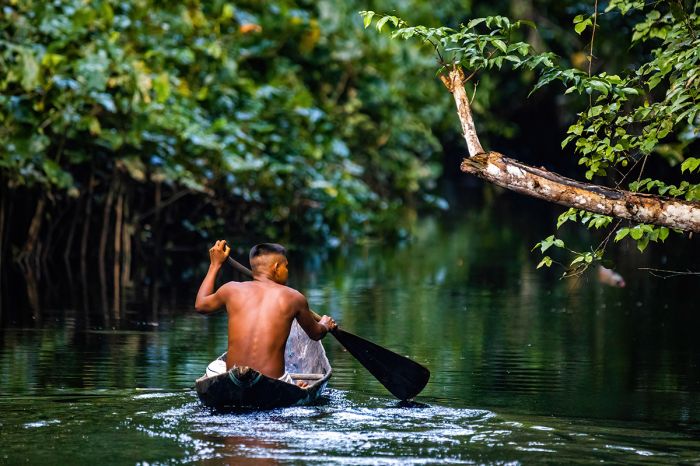
An indigenous man canoeing in the Amazon, Peru.
The Amazon is a must-see for nature lovers and Peru has a good number of jungle-based lodges that offer opportunities to see some of its wildlife, including jaguars, caimans, tapirs, capybaras, giant anteaters, otters, huge anacondas, sloths, and an abundance of primates. Birding in the Peruvian Amazon is outstanding and almost any lodge or camp offers expert birding guides.
Visitors will also likely see indigenous people that live in small villages along the waterways and still survive in traditional ways by hunting and fishing.
There are two distinct Amazonian destinations in Peru, one in the southeast just east of Cusco, and the other, a much larger section of rainforest in the far northeast.
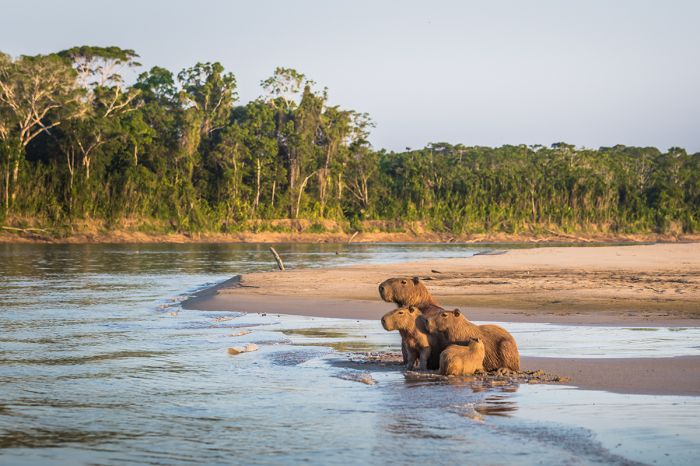
Capybaras on the bank of the Madre de Dios River in Manu National Park, Peruvian Amazon.
SOUTHERN AMAZON
Peru's southern Amazon is also known as Madre de Dios, named for the wide river which flows though heart of the southern selva (jungle in Spanish). The small, frontier, river town of Puerto Maldonado is where all visits to the southern selva begin. The town is a 90-minute flight from Cusco, so it makes sense to join these tow destinations on your travel itinerary. Wildlife and birding are the main attractions in the southern selva and there are lodges offering incredible experiences on both boat and on foot.
The Manú Biosphere Reserve protects 7 700 square miles of virgin forest (both cloud forest and rainforest) and is divided into three zones as follows. Zone A is the core zone (covering 80%) and is a national park (Manu National Park) with strict regulations and only accessible to tourists on organized visits with a licensed guide). Zone A has no permanent residents beyond some virtually unknown indigenous groups, the park guards, some researchers, and the wildlife. Zone B is a buffer zone (covering 10%) and is used for both research and tourism, with several excellent lodges. Zone C is a transitional zone (covering 10%) with some human settlement and some tourist lodges.
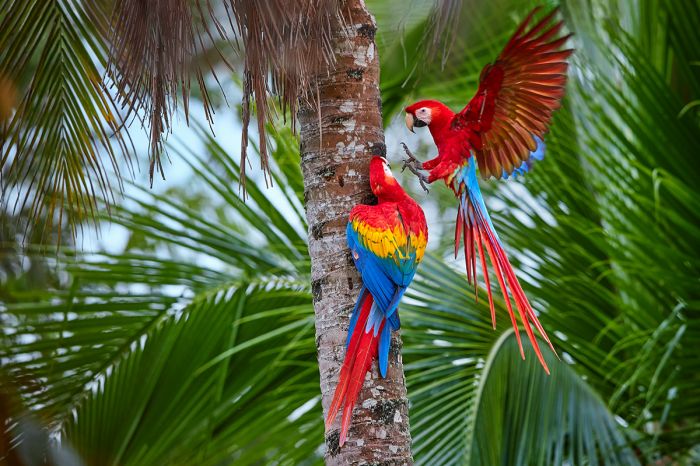
A nesting pair of Scarlet Macaw (Ara macao) in Manu National Park, Peru.
The other option in the southern Amazon is Tambopata National Reserve, which covers 1 061 square miles of pristine rainforest and has a variety of excellent tourist lodges to choose from. Access to the lodges in Tambopata, which are mostly situated along the Tambopata River, is by boat from Puerto Maldonado. The lodges in Tambopata offer outstanding wildlife experiences with expert guides, many of whom grew up in the forest.
To the south of Tambopata lies the massive Bahuaja-Sonene National Park, which covers 4 214 square miles and extends to Bolivian border to the east, where it adjoins to that country's Madidi National Park. The combined parks and reserves in this section of the Amazon are one of the largest protected areas in the world and certainly one of, if not the most, biodiverse areas on Earth.
For more information about Peru's Southern Amazon, visit the Peruvian Amazon - South region page.
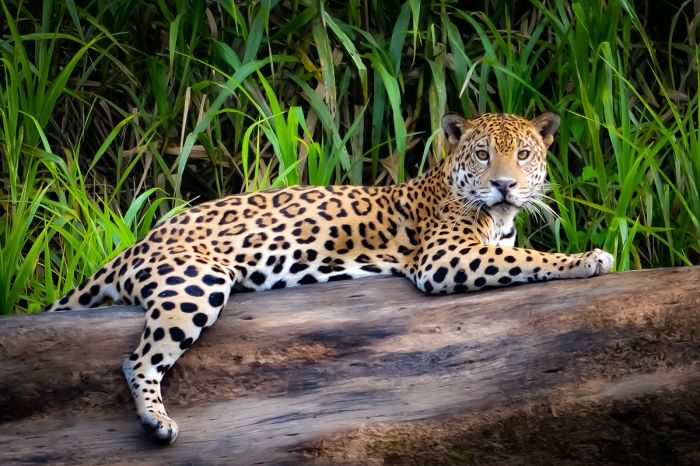
A Jaguar relaxes on a tree trunk on the banks of the Tambopata River, Tambopata National Reserve, Peruvian Amazon.
Northern Amazon
Peru's northern selva offers diverse jungle adventures and is centered around the island city of Iquitos, which is situated on the bank of the Amazon River, as it flows east towards Brazil.
Multiple tributaries of the Amazon River flow from the Andes Mountains in western Peru and join together upstream from Iquitos, so by the time the water reaches the city, the river is several kilometers in width. The only means of reaching Iquitos is by air or boat and the lively, tourism-based town offers local culture and fascinating architecture.
The array of waterways around Iquitos offer visitors a chance to experience indigenous villages and explore the dense, primary rainforest of the Amazon basin. There is a good selection of excellent lodges along the Amazon River in both directions from Iquitos.
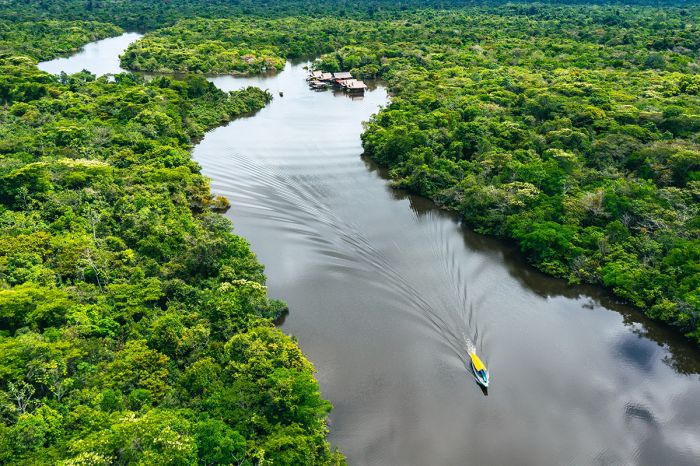
Aerial view of a boat on the Rio Momon, a tributary of the Amazon River, near Iquitos, Peru.
Additionally, unlike the southern section of Peruvian Amazon (discussed above), tourists can hop onto one of the multi-day, river boat cruises that offer luxurious guest suites and exploration along the Amazon River.
The cruises include guided day excursions on foot and smaller skiff boats, allowing guests access to wildlife living in the thick forest along the river. Some of the cruise vessels accommodate up to 40 passengers, while others have only 4 suites. The smaller vessels are ideal for small groups, who can take sole use of the cruise. The boat cruises all depart from and return to Iquitos.
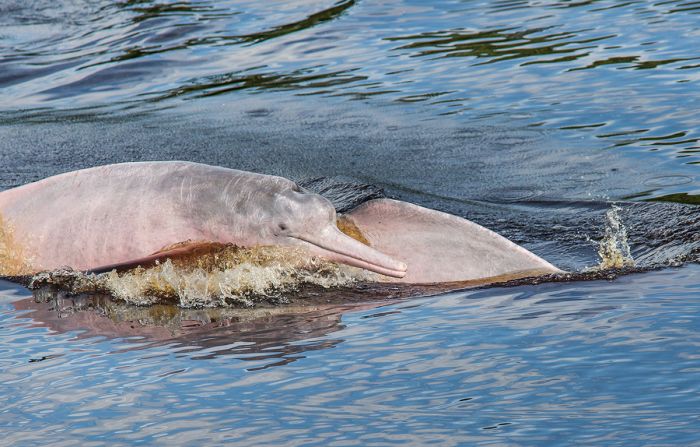
Amazon river dolphins (Inia geoffrensis), locally called 'Boto', can be seen in the Amazon River.
Located south of Iquitos and upriver is the 8 000-square-mile Pacaya-Samiria National Reserve. The reserve protects the largest area of seasonally-flooded, Amazonian jungle in Peru. The reserve is bordered on the north by the Marañon River, which is one of the largest headwaters of the Amazon River.
There are countless smaller waterways and oxbow lakes in the reserve and its pristine rainforest is home to myriad wildlife, including jaguar, caiman, river dolphin, manatee, otter, multiple species of primate, and over 450 species of bird.
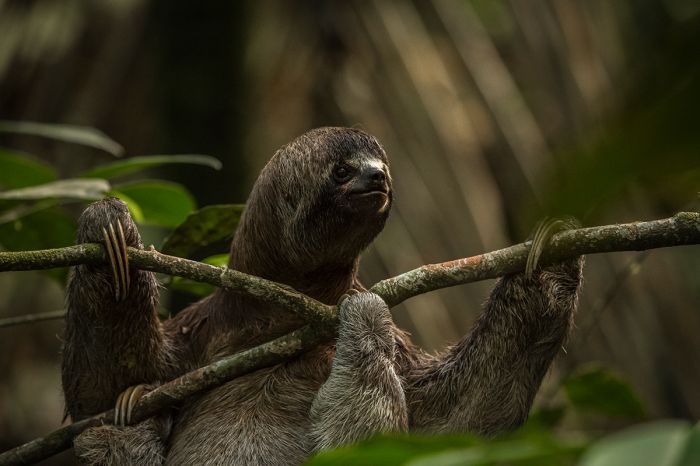
A brown-throated sloth (Bradypus variegatus) in Pacaya-Samiria National Reserve, Peru.
The reserve is only accessible on a cruise or private boat excursion with a guide. There are a few jungle lodges in Pacaya-Samiria that offer incredible Amazon experiences. The lodges will provide boat transfers from Iquitos to the small town of Nauta and from there, a speedboat transfer to the lodge. Although Pacaya-Samiria is more difficult to reach than the lodges close to Iquitos, the experience of being remotely located, far from most of the tourists, is well worth the effort.
For more information about Peru's Northern Amazon, visit the Peruvian Amazon - North region page.
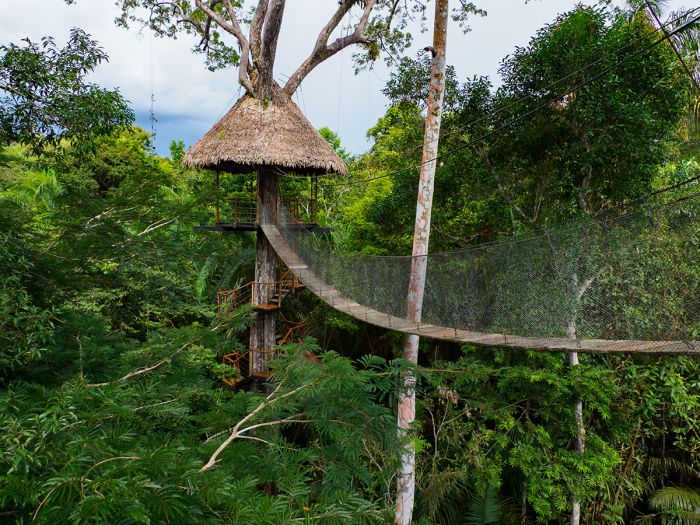
Luxury treehouse accommodation at a lodge in Pacaya-Samiria National Reserve, Peru.
Lima
Lima, with a total metro area population of over 11 million (including the seaport city of Callao), is Peru's capital city. The city was founded in 1535 by the Spanish, who, led by Francisco Pizarro, conquered the Inca Empire that ruled this area when the Spanish arrived.
By the 1550's, Spanish Lima had numerous extravagant mansions and shops operated by wealthy merchants; quickly becoming the capital of Spanish viceroyalty encompassing not just Peru, but also Chile, Bolivia, and Ecuador. Lima remained the most important and wealthiest city in South America until the early 1800's.
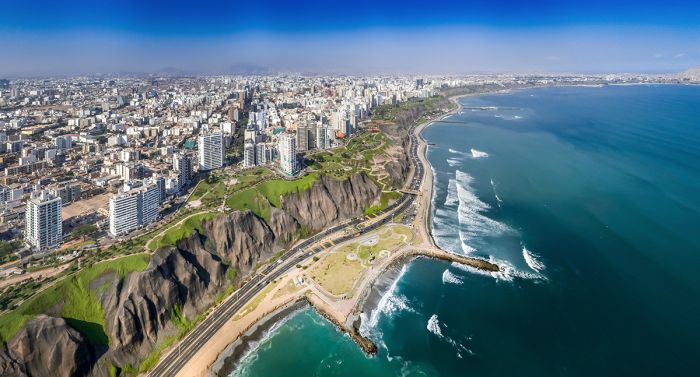
Aerial view above Lima's Miraflores suburb showing the seacliff and Costa Verde highway.
Lima's Historic Centre (Lima Centro) is filled with interesting Spanish structures that were built where Inca palaces and temples stood before the arrival of the Spanish. This section of Lima was declared an UNESCO World Heritage Site in 1988 in recognition of the "architecture and urban development of a Spanish colonial town of great political, economic and cultural importance in Latin America". A guided historic tour of Lima is highly recommended.
South of Lima Centro is Miraflores, a modern and affluent suburb with an abundance of shops, cafes, businesses, hotels, restaurants, and nightlife. Some of Lima's most popular beaches are situated directly below the sea-cliffs of Miraflores. Other suburbs offering good accommodation include Branch, San Isidro, and San Miguel.
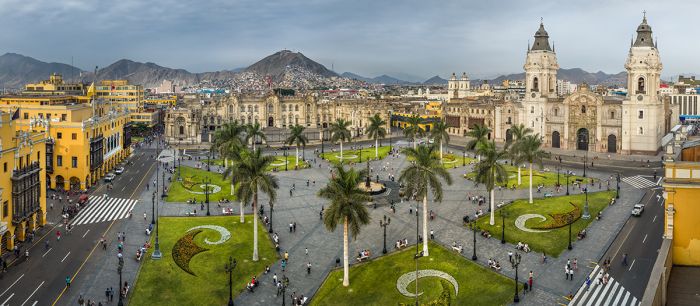
Lima's main square, the Plaza de Armas, is surrounded by the Government Palace, Lima Metropolitan Cathedral, Archbishop's Palace of Lima, the Municipal Palace, and the Palacio de la Unión.
Southern Peru
The southern coast of Peru is replete with interesting cultural sites. Additionally, the Andes Mountains provide spectacular scenery, with volcanos, lakes, and dramatic canyons, all of which provide a playground for outdoor adventure.
Most notably, the far south has two distinct and worthwhile destinations. The first is the city of Arequipa and its surrounding area, located inland from the west coast and the other is Lake Titicaca, situated at high altitude in the southeast.
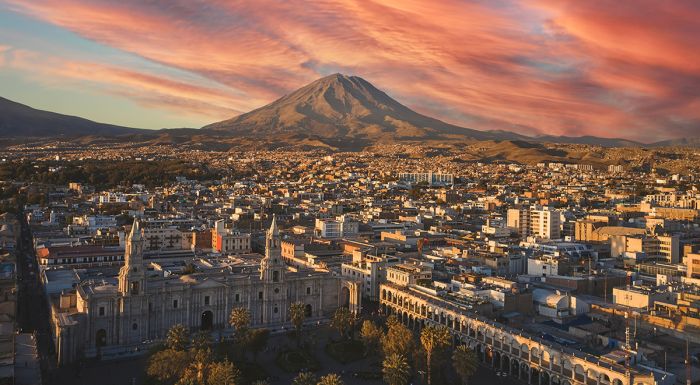
Aerial view of Arequipa, showing El Misti volcano in the diatance.
Lake Titicaca is the highest navigable lake on Earth and the largest high-altitude lake in the world, covering 3 200 square miles and sitting at 12 556 feet above sea level. The lake extends south into Bolivia and is worth visiting to learn about the pre-Inca cultures that lived on the lake shore.
There are over seventy islands in the lake and the unusual "Islas de los Uros", small, floating platform islands made from reeds, can be visited on any lake tour. The floating islands are inhabited by extended families and usually some livestock and pets. The lakeside town of Puno offers good accommodation.
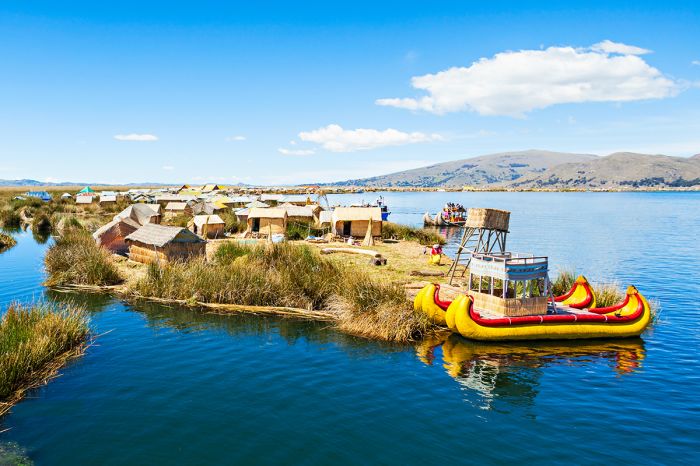
Lake Titicaca's "islas de los Uros" are floating islands, some of which can be visited by tourists.
Often called "La Ciudad Blanca" (the white city), Arequipa is a must-see city in southern Peru. The city is situated in a gorgeous setting at the base of the El Misti volcano and enjoys a very pleasant climate. In spite of a disastrous earthquake in 1687, Arequipa still boasts some of Peru's finest colonial churches and mansions, many of which were fabricated from white sand and coral, leading to its nickname of the white city.
The city center of Arequipa houses numerous religious buildings dating back to the early Spanish colonial times, including the Monasterio de Santa Catalina, a spectacular, thick-walled complex that is the city's most popular tourist site. The Plaza de Armas is the focus of Arequipa's social and night life and there are plenty of hotels, restaurants, and shops on offer to tourists. A city tour of Arequipa is a must-do.
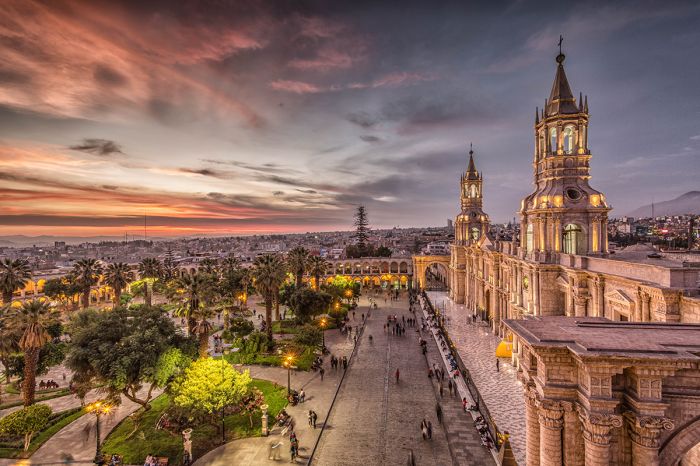
Sunset view along Arequipa's main square, southern Peru.
Northern Peru
Peru's northern coast is characterized by fewer tourists, excellent beaches, cultural and archeological sites, and a lovely, warm and dry coastal climate.
The city of Trujillo is located on the coast at the eastern edge of a vast desert plain and is the main tourist destination. There are nearby Inca and pre-Inca ruins that can be explored, most notably Chan Chan, but also in the city centre. Trujillo also has excellent sandy beaches and day trips into the Andean highlands are another great option.
The nearby mountain town of Cajamarca is a must see, as is the historic town of Chachapoyas.
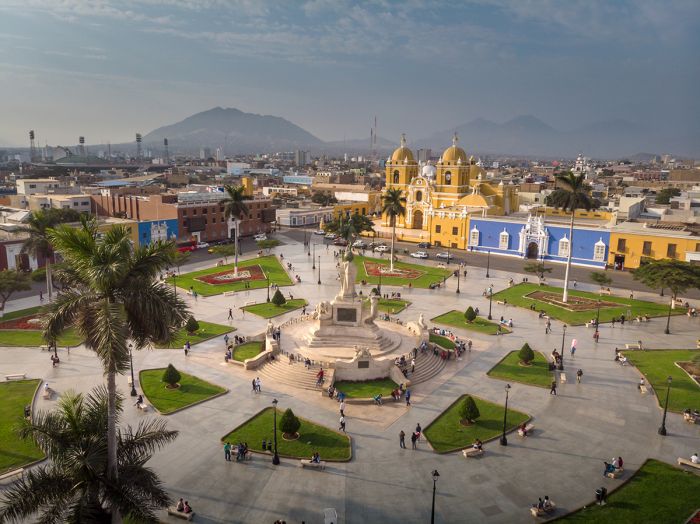
Aerial view of Trujillo's main square.
Andes Mountains
The Andes Mountains are the longest continental mountain range in the world, forming a continuous highland along the western edge of South America. The range is 5 530 miles (8 900 kilometers) long and has an average height of about 13 000 feet (4 000 meters). The Andes stretch from South to North through seven South American countries: Argentina, Chile, Bolivia, Peru, Ecuador, Colombia, and Venezuela.
The Andes can be divided into three geographic sections: the Northern Andes in Venezuela, Colombia, and Ecuador, the Central Andes in Peru and Bolivia, and the Southern Andes in Argentina and Chile.
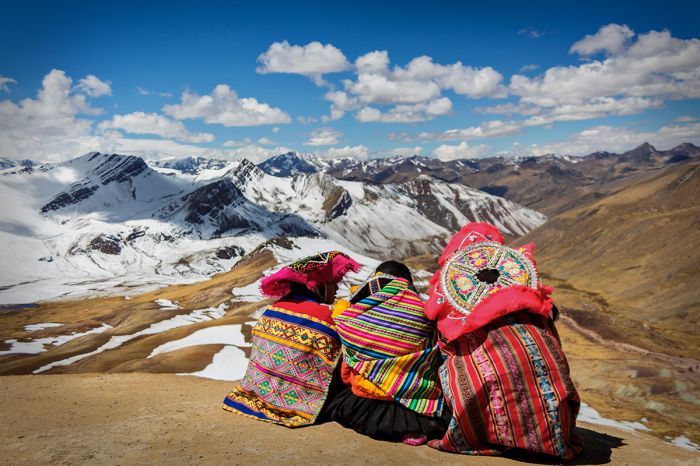
Local women in traditional attire in the Peruvian Andes.
The Andes are the highest mountain range outside of Asia. The highest peak in the Andes is Argentina's Aconcagua, which rises to an elevation of 22,838 feet (6,961 meters). The Andes also contains the highest volcanoes on Earth, including Ojos del Salado on the Chile-Argentina border, which rises to 22,615 feet (6,893 meters).
The Peruvian Andes are rich in culture, history, and sites to visit. The Andes Mountains of Peru include numerous Inca Empire ruins, the most notable of which is Machu Picchu, an UNESCO World Heritage site and a very popular tourist destination.
In the southern part of the Peruvian Andes is Lake Titicaca, the world's highest navigable lake. The Colca Canyon is a 60-mile-long canyon carved by the Río Colca. The canyon is replete with mountain villages and ancient agricultural terraces.
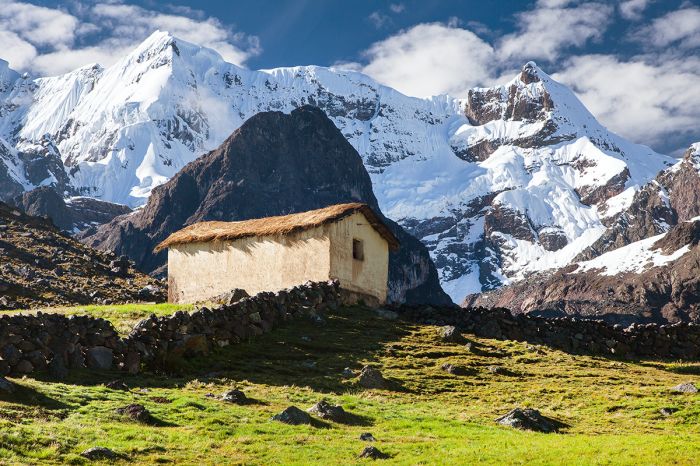
A small dwelling in Peru's Andes mountains.
Cordillera Blanca
Southeast and inland from Trujillo is the highest tropical range of mountains in the world, known as the Cordillera Blanca. The Cordillera is comprised of 35 snow-capped peaks above 6 000 meters (19 685 feet). One of these peaks is Huascarán (22 205 feet / 6 768 meters), Peru's highest peak.
Visitors come to this area mainly for hiking, trekking, and climbing, but there is also a vast desert lying to the west and extending all the way to the Pacific coast, where ancient pyramids, temples, and fortresses are scattered amongst lengthy, empty beaches. There are many pre-Columbian archeological ruins that can be explored and the area is rich in culture.
The best place to base for visiting the region is in the town of Huaraz, which offers plenty of accommodation, open-air markets, and a lively city centre. The area around the town offers ancient ruins, natural thermal baths, and spectacular mountain scenery.
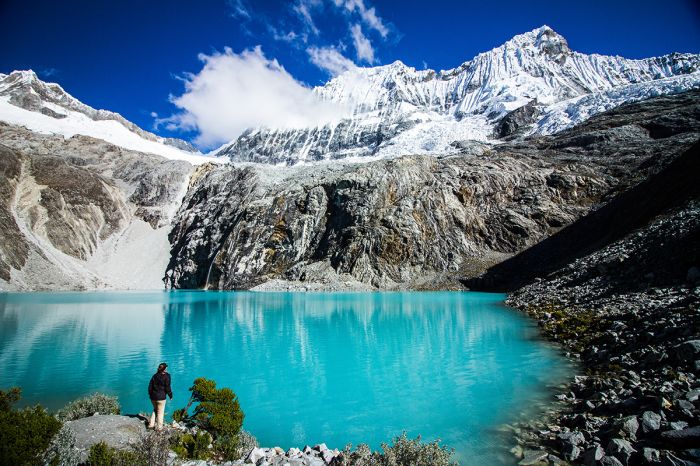
A hiker admiring Laguna 69, with Nevado Chacraraju mountain in the background, Huascaran National Park.
There are some spectacular high-altitude lakes in the Cordillera, including Lake Parón, which is known for being one of the most beautiful in Peru, and Lagunas de Llanganuco, with waters that change color seasonally. All together, there are some 300 glacial lakes in the Cordillera Blanca. For hiking, there are many commonly-used trails available, some of which can be hiked by anyone, but the more adventurous routes require a local guide.
Huascarán National Park lies directly east of Huaraz town and is home to two awe-inspiring, deep-water lakes known as the Laguna de Llanganuco, which are at an elevation of 12 630 feet (3 850 meters). The park also protects Peru's most spectacular peak, the glaciated Huascarán. Hikers can easily summit Huascarán via a steep, but relatively short 3-km trail. The scenery here is jaw-dropping and there are various other lakes that are quite magical to see.
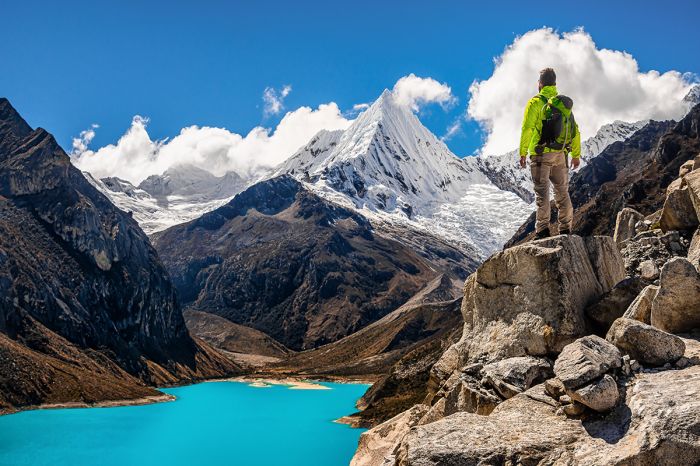
Hiking in the Cordillera Blanca.
Great Good Fair Poor
- Jan
- Feb
- Mar
- Apr
- May
- Jun
- Jul
- Aug
- Sep
- Oct
- Nov
- Dec
The chart directly above is a rough overall indicator of best times to visit Peru. Click on a Region Link above to read more about best times to visit a specific region or destination.
Year-Round Destination
Peru is a year-round destination but it does experience slight climatic variations across its major geographic regions (Andes Mountains, low-lying Atlantic Ocean coast, and low-lying Amazon Rainforest). There are only two, somewhat distinct seasons - one relatively dry and the other which receives increased rainfall.
Slight regional climate variations are most noticeable in the Andes mountains and in the low-lying Amazon. The Atlantic coastal regions along the west side of Peru, as well as the mountainous regions lying further east are cooler and drier, while the Amazon rainforest along the eastern side of Peru are lush and warmer.
Average temperatures do vary slightly across Peru's regions. Daytime temps along the cooler Atlantic coast range from 68-80°F (20-27°C), while temps in the Sacred Valley have year-round temps averaging 66-68°F (19-20°C). Of course, the Amazonian regions are much warmer and more humid, with year-round daytime temps ranging from 86-91°F (29-33°C). Daytime temps in Lima are pleasant all year, ranging from 66°F (19°C) in July/Aug to 81°F (27°C) in Feb/Mar.
Dry Season
The best time for a visit to Peru is during the drier months from May thru October. This is particularly true if your itinerary includes a mountain trek. Peru's dry season (May thru October) offers lovely, sunny days and comfortable temperatures, but because of this, there are more tourists, prices for flights and most accommodations are higher, and booking your travel well in advance is much more important.
Those planning a dry season trip to Peru should start planning their trip six to nine months in advance and up to twelve months in advance if you are trekking the Inca Trail, especially if your travel dates are inflexible.
Green Season
The months from November thru April see more rainfall, especially in the low-lying jungle regions of the Amazon rainforest. A visit during the green season will still be worthwhile, as rains do not typically set in for long periods and there are far fewer tourists, as well as somewhat lower pricing at most accommodations.
Trekking
Trekking, including the Inca Trail trek to Machu Picchu, is best during the drier months because the trail and its many stone steps become slippery when there has been rain. The trail closes for the month of February (typically the wettest month) each year for safety reasons and for trail maintenance. Note that although the Inca Trail closes during February, Machu Picchu is still open and be visited via the train journey from Cusco.
It is particularly important to reserve spots (which are strictly limited on any given day) for the Inca Trail well in advance (up to a year) if you are planning during the dry season.
Amazon
Water levels in the Amazon's myriad rivers and smaller channels are highest from December thru March, so some of the land-based fauna are not as easily seen from boats, but the higher water offers the advantage of being able to explore areas not possible to see when the water levels are lower during the dry season.




